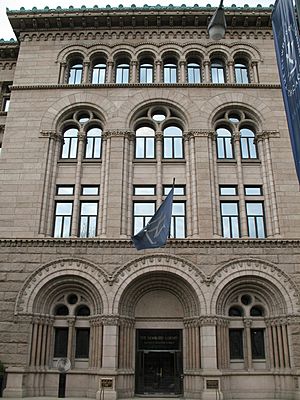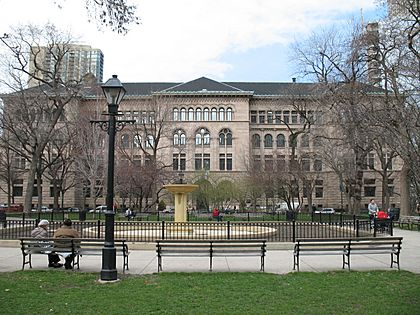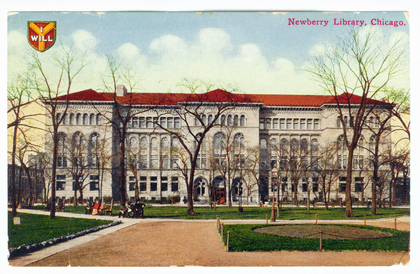Newberry Library facts for kids
Quick facts for kids Newberry Library |
|
|---|---|
 |
|
| Type | Independent research library |
| Established | 1887 |
| Location | Chicago, Illinois, US |
| Criteria for collection | Humanities |
| Access and use | |
| Access requirements | Age 14, with research interest served by the collection; open access digital collections online |
| Circulation | non-circulating reference library |
| Other information | |
| Director | Daniel Greene |
The Newberry Library is a special research library in Chicago, Illinois. It focuses on the humanities, which means it collects materials about human culture, history, and ideas. The library is located near Washington Square and has been free and open to everyone since 1887.
The Newberry Library has many collections about the history and culture of Western Europe and the Americas from the last 600 years. It was named after Walter Loomis Newberry, a kind person who left money in his will to start the library.
Some of the main topics you can find at the Newberry include:
- Maps, travel, and exploration
- Music from the Renaissance (a period of European history) to the early 1900s
- The history of printing
- Family history (genealogy)
- The early meetings between European settlers and Native peoples in the Americas
- Papers from American journalists of the 1900s
Even though you can't check out books from the Newberry, it welcomes researchers who are at least 14 years old. You can also enjoy public events like art shows, talks by authors, and classes for adults.
Contents
History of the Newberry Library
The Newberry Library began in 1887 because of a gift from Walter Loomis Newberry. He was an important businessman in early Chicago, involved in banking, shipping, and real estate. Walter Newberry passed away in 1868. In his will, he said that if his daughters died without children, money should be used to create a "free public library."
His daughters did pass away without heirs. After his wife, Julia Butler Newberry, died in 1885, two trustees, William H. Bradley and Eliphalet W. Blatchford, started the library.
Newberry didn't leave many details about what he wanted for the library. Also, his own book collection was lost in the Great Chicago Fire of 1871. So, the first people in charge had to decide what kind of library it would be.
The first librarian was William Frederick Poole. He was a very important person in the library world. Poole saw the Newberry as a chance to build a library exactly how he thought it should be.
The library moved a few times in its early years. The building you see today opened in 1893. It was designed by Poole and architect Henry Ives Cobb. It's located at 60 West Walton Street, across from Washington Square. The building is made of granite and has a Spanish Romanesque style.
Poole and Cobb had different ideas for the library building. Poole wanted many reading rooms where people could easily reach books on open shelves. Cobb preferred a grander style, like libraries in Europe, where books were kept in a central storage area. Poole convinced the library's leaders to make Cobb change his plans to include open shelving. However, over time, open shelves became too difficult for the staff and for keeping the books safe. So, the library eventually switched to a central storage system.
Poole was the Newberry librarian until he died in 1894. Under his leadership, the library collected many general reference books that would be helpful to people in Chicago, especially professionals and tradespeople. For example, a medical department was created in 1890. Poole also started buying rare and special materials for scholars. During his time, the library bought important collections from Henry Probasco and Count Pio Resse. These included rare music, early printed books, and special editions of Shakespeare, Homer, and Dante.
To avoid collecting the same books as other libraries in Chicago, the Newberry made an agreement in 1896. They worked with the Chicago Public Library and the John Crerar Library. Each library would focus on different subjects. The Newberry chose to specialize in the humanities. The Crerar Library focused on natural sciences. Because of this, the Newberry moved its science books, including its copy of Audubon's Birds of America, to the Crerar. The medical department also moved to the Crerar in 1906.
Stanley Pargellis was the fifth Newberry librarian (from 1942 to 1962). He believed the library should not just collect materials, but also create programs to help people study them. Under Pargellis, the library started a fellowship program, which gives money to scholars to do research. They also held academic meetings where new studies using the library's collections were shared.
Pargellis also added new types of collections. He understood how important companies were in American life. He believed that company records should be available for study. So, he started a trend by buying the private papers of the Chicago, Burlington & Quincy Railroad Company in 1943. Since then, the Newberry has continued to collect records from other major companies in the Midwest.
Between 1962 and 1986, the library grew a lot under the leader Lawrence William "Bill" Towner. During this time, the Newberry got many important collections. A new building was built just for storing books. The library also created its four research centers. These centers still support important studies and offer programs for everyone. They are:
- The Center for Renaissance Studies
- The D'Arcy McNickle Center for American Indian and Indigenous Studies
- The Hermon Dunlap Smith Center for the History of Cartography
- The William M. Scholl Center for American History and Culture
Under Towner, the library also collected many materials about the writer Herman Melville.
In 2017-2018, the library's main entrance area was renovated. This $12 million project made it easier for visitors to enter and improved the space for exhibitions.
What the Newberry Library Offers Today

The Newberry Library holds more than 1.5 million books, 5 million pages of handwritten documents, and 500,000 old maps. Its collections are especially strong in these areas:
- The European Renaissance
- Genealogy (family history)
- Indigenous peoples of the Americas
- Early music
- Cartography (map-making)
- The history of printing
- Chicago history
- Railroad records
- History of Brazil and Portugal
- Papers from writers in the Midwest
Some of the most famous items at the Newberry include:
- A Shakespeare First Folio (a very early collection of Shakespeare's plays)
- Letters from Thomas Jefferson
- Sketches by Oswald Bruce Cooper for a famous typeface called Cooper Black
- Original woodblocks made by Thomas Bewick (used for printing pictures)
- A fur trade contract from 1692 that is one of the earliest mentions of "Chicagou" (Chicago)
- The oldest copy of the Popol Vuh (a sacred book of the Maya people)
The library also has a collection of old books about magic. They invite visitors to their website to help translate and copy these books.
The Newberry offers many public programs. These include art shows, talks by authors, continuing education classes, concerts, and programs for teachers. Recent exhibitions have shown Daniel Burnham's famous Plan of Chicago from 1909, items from World War I, and a collection of materials about love, like heart-shaped Renaissance maps.
The library's Research and Academic Programs Division offers special study programs for scholars from all over the world. They also have two semester-long classes for college students. The four research centers help create and share new knowledge in their fields:
- Medieval, early modern, and Renaissance studies
- American Indian and Indigenous Studies
- The history of maps
- American history and culture
Librarians are available in the Newberry's reading rooms to help all visitors. They can give tours, teach you how to find information, and offer special help if you need it. Anyone over 14 years old can use the library for research.
The Newberry Library was the main place that created the 2004 Encyclopedia of Chicago. This important book covers Chicago's history from 1630 to 2000.
The Atlas of Historical County Boundaries Project is also based at the Newberry. This project uses computer mapping to show how county borders in the United States have changed from the 1600s until today.
The Newberry Bookstore is in the library's lobby. It sells books that match the library's collections and upcoming events. You can also find cards, posters, and other fun items there.
Newberry Library Award
In 1987, the Newberry Library started the Newberry Library Award to celebrate its 100th birthday. This award honors people and organizations who have made "outstanding contributions to the humanities," especially in areas related to the Newberry's collections. The award itself is a small model of the Umanitá sculpture by Virginio Ferrari. The full-sized sculpture greets visitors when they enter the library.
- 1987: Paul Oskar Kristeller
- 1990: Jaroslav Pelikan
- Richard J. Franke
- Ann Ida Gannon
- Lawrence Stone
- 2006: Hanna Holborn Gray
- 2007: Richard M. Daley
- 2008: Anthony Grafton
- 2009: William Cronon
- 2010: Jonathan Spence
- 2011: Robert Darnton
- 2012: Francis Christopher Oakley
- 2013: David McCullough
- 2014: Roger Baskes
- 2015: Stacy Schiff
- 2016: Andrew W. Mellon Foundation
- 2017: Martin E. Marty
- 2018: Carla Hayden
See also
 In Spanish: Biblioteca Newberry para niños
In Spanish: Biblioteca Newberry para niños



